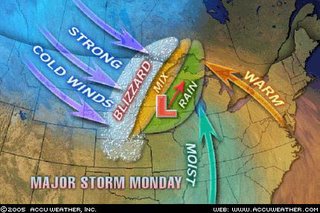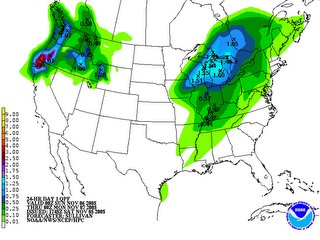
Click here for November Forecasts
Graphics courtesy of Accuweather.com
As shown above, conventional forecasters are predicting a major East Coast storm Monday and Tuesday, November 21-22, 2005.
Accuweather states "Adverse weather with the big East Coast storm will begin in the Southeast late Sunday and early Monday before spreading quickly through the Eastern Seaboard to New York and New England Monday through early Tuesday... Much of Florida and Georgia through the coastal plain of the Carolinas and southeastern Virginia will have a threat of severe local thunderstorms, including hail, high winds and even isolated tornadoes... Another factor will be that of high winds, especially coastal winds, as the storm spins up dramatically late Monday through Tuesday. New England will bear the brunt of coastal winds along with tide and wave action, but there will be strong winds well inland at this time too. As if these were not enough, there will be a wintry side to the storm, too. Cold air will pour into the Midwest Monday night and Tuesday.
(Bold print added by The Weather Alternative)
On September 9th of this year, The Weather Alternative posted forecasts for November 2005. The East Coast storm and the cold air entering the Midwest were mentioned in these forecasts although the timing seems to be a day or so off.
For example, the cold air to pour into the Midwest on the 21st and 22nd was mentioned in the November 19-20 forecast:
"Another bout of blustery weather and lower temperatures is shown for the Mississippi Valley and Eastern U.S. "
The East Coast storm scheduled for Monday and Tuesday November 21-22 was specified in The Weather Alternative forecast for November 23-24:
"The clash between high and low pressure systems will focus on the coastal areas of Virginia and North Carolina. High winds or severe storms are likely to hit this area. This may be part of a larger weather pattern that affects the Mid-Atlantic area."






